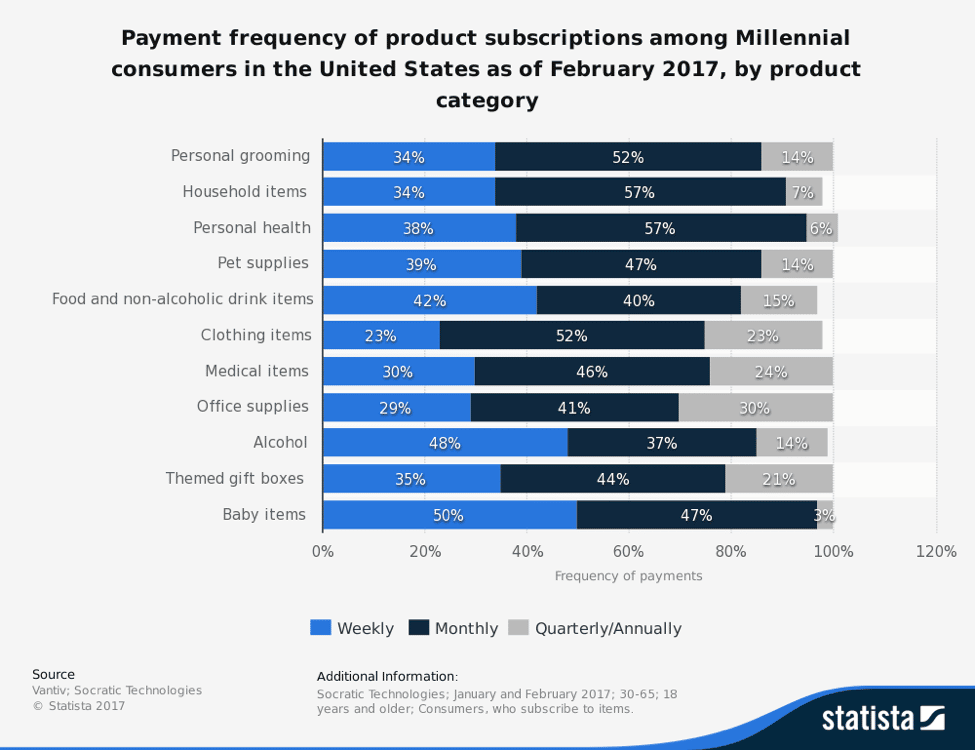Source: Bigstock

The growing value of recurring payments is obvious to companies who want to be paid — but even consumers, which is to say, spenders, are recalibrating old payment habits to fit a new financial lifestyle. Checks don’t translate online. Our finances are not so much a matter of cash on hand but more a mental bottom line, made real in a virtual existence online, that moves the account balance down and up as we spend and get paid. Credit cards have nothing to do with loans and everything to do with digital wallets. For debit cards, even more so. A magazine subscription, a monthly food box, a streaming music service … these are just more things to move the balance down.
A look at the data reveals the widespread acceptance of the use of plastic for subscription payments.

(Source: Socratic Technologies via Statista)
Credit cards are used by 46% of credit card holders to make automatically recurring payments. That’s the fourth most popular use, tied with buying clothes. And when using debit cards, paying for subscriptions is the number two use:

(Source: Socratic Technologies via Statista)
Only paying for groceries beats paying for subscriptions when tallying debit card use.
It’s not just consumers who want to use credit cards to pay for subscriptions. According to the Wall Street Journal, corporations want workers to use plastic for expenses, too, including ongoing expenses.
- The shift to plastic could help companies net some savings. Suppliers often offer discounts to businesses that pay for goods swiftly, rather than 30 to 60 days after receiving a shipment. Companies can set up automatic, recurring credit-card payments to suppliers to make sure they take advantage of those offers.
KIDS THESE DAYS
For consumers who came of age after the dot-com boom of the Nineties, the idea of paying for recurring services with a physical check seems more and more like a relic of the past. Modern, younger subscribers do not hesitate to use their credit cards online for one-time and recurring payments. Which is not to say that Boomers are tied to their checkbooks, of course! Ease of use and convenience of using electronic payment options have won these consumers over too. According to Accenture, Millennials are teaching new shopping habits to their parents.
- Our research shows that Millennials are not only transforming their own shopping behaviors but those of their parents, who are increasingly mimicking the demands of their children for seamlessness as they climb the digital learning curve.
Still, the difference between cohorts is striking. Take a look at Millennials vs Gen-Xers and their frequency of payment preferences. First, the Gen-Xers:

(Source: Socratic Technologies via Statista)
Compare that with the Millennials:

(Source: Socratic Technologies via Statista)
Millennials are happy to set up payment methods on a more frequent basis than the generation that preceded them (who remain more often locked in a “monthly” or even “annual” mindset).
This flexibility demonstrates that Millennials tend to be experimenters as consumers. As Artem Tymoshenko at PaymentsSource.com writes, “Millennials seem to be voting with their wallets for the convenience provided by these subscription services.”
- As subscription services continue to grow, businesses will see most spending lump as regular purchases with suppliers on a recurring basis. These transactions are likely to be subscriptions made by millennials as their purchasing power continues to grow and is expected to reach $1.4 trillion by 2020. … A subscription is not a way to lock your clients’ money in your vault and traditional business practices to maintain customer loyalty still apply and re-enroll people who fall through the cracks will pay dividends in the long run.
BUILDING BACKLASH
However, locking your customers into recurring deductions from their credit card accounts, as good as it sounds for everybody, has its hazards, and it is even developing a bit of a bad reputation. Here are a few of the potential pitfalls.
Jumping ship. The flip side of courting financially savvy customers — both Millennials and the Gen-Xers and Boomers who have embraced their habits — is that these canny consumers do not hesitate to unsubscribe if they do not perceive the value of the product. A PWC survey comments, “Expect them to go: It’s inevitable that the rate of churn among millennials will be higher than among other generations.” Goldman Sachs notes that Millennials “are used to instant access to price comparisons, product information and peer reviews.” This makes it important to keep them satisfied, and to continue to stress customer support and the entire customer relationship.
Giving the industry a bad name. The importance of good customer service goes beyond that, however: It is important not to defraud your customers! It seems obvious, but do not put up high barriers to cancellation. Do not continue to bill customers who have quit. Do not make it impossible (or even hard) to contact you. When you are sued over this issue, don’t try to trick the judge, like Spotify lawyers did. The problem is that unethical companies do engage in fraud; gyms offering memberships are notorious for it. There are tons of articles for consumers with advice on how to quit memberships, such as this one in Gizmodo. The New York Times is advising readers on “Cutting Off Those Recurring Charges You Forgot About.” As Law360 reports, states are making auto-renewal practices illegal.
- Although subscription-based services can benefit consumers by offering simplicity and lower prices, legal issues emerge when customers claim that they did not knowingly agree to continue paying for future products or services. In the past several months, these customers have filed several class actions against retailers of all kinds, pursuant to both state and federal laws.
Dealing with credit card companies. Inserting an intermediary into the provider/subscriber relationship does present its own challenges. Of course, we see it at the pump: gas stations charge less when customers use debit cards and cash. Subscription companies don’t have the luxury of offering different prices like that. And it goes deeper, when you consider the headaches of chargebacks. Ben Bradley and Macon Raine at FinExtra point out that “the chargeback dispute process does not favor recurring merchants.”
- While recurring merchants shouldn’t fight every chargeback, it’s worse to do absolutely nothing. Careful analysis of every chargeback claim is necessary to ensure that the chargebacks that can be fought are fought. In some cases, the amount a merchant stands to win is significant. In these cases, the merchant should follow through with chargeback re-presentment. Doing nothing means the merchant is guaranteed to lose 100 percent of its profits in every chargeback case.
A solid read of this FinExtra article offers more concrete tips for fighting chargebacks.
Hurting the consumer experience. Do not forget that when the system fails, subscribers suffer from dealing with credit card companies too. At Forbes, Claire Tsosie notes that “Paying recurring bills by credit card is the easiest thing in the world – until it isn’t.” She cites user hassles such as
- Needing to update card information when cards expire or change;
- Dealing with the fallout when a card is stolen or hacked;
- Paying fees associated with card companies.
The takeaway here for subscription-based companies is to make customer service options so user-friendly that these kinds of issues are not as painful to subscribers when they pop up. That’s the kind of service that wins loyalty.
Insider Take
Customers want to manage their subscriptions effortlessly, and they use their credit cards to make that happen. Serving these needs well will build satisfaction and decrease churn. Publishers, retailers, and service providers need to recognize that a business model that supports these financially savvy — and often younger — subscribers is key. That’s “supports,” not “defrauds”!






